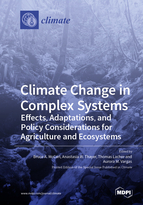Climate Change in Complex Systems: Effects, Adaptations, and Policy Considerations for Agriculture and Ecosystems
A special issue of Climate (ISSN 2225-1154).
Deadline for manuscript submissions: closed (31 January 2020) | Viewed by 51982
Special Issue Editors
Interests: climate change; climate change mitigation; water economics; policy; mathematical programming
Special Issues, Collections and Topics in MDPI journals
2. Department of Applied Economics at Utah State University, Logan, UT, USA (starting January 2020),
Interests: resource economics; agricultural economics; climate change
Interests: conservation biology; tropical ecology; conservation planning; biodiversity
Special Issues, Collections and Topics in MDPI journals
Special Issue Information
Dear Colleagues,
To date, much of the land- and water-related literature on climate change effects and adaptation efforts has generally focused on either agriculture or ecosystems. Consequently, the interdependence of agriculture and ecosystems through runoff, trade-offs, feedback loops, and synergistic effects has been largely overlooked. Given that global climate change is expected to lead to pronounced changes to both of these systems, independent analyses of these systems might overlook the key interrelationships necessary for understanding the vulnerabilities, adaptation possibilities, and outcomes. In contrast, comprehensive research efforts that consider both systems concurrently are likely to provide more comprehensive and accurate conclusions.
In this Special Issue, we seek research that explores climate change effects and adaptation at the intersection of agriculture and ecosystems. Possible topics could explore and evaluate (1) agricultural vulnerabilities and adaptations, including implications for environmental quality and biodiversity; (2) ecological vulnerabilities and adaptations, including implications for agriculture; (3) joint resource management issues; and (4) how agricultural–ecology interdependencies and feedbacks will influence the scale and nature of climate effects and adaptive actions. Emphasis will be placed on drawing implications across the interrelated agricultural and ecological landscapes, while identifying challenges for policy and adaptation efforts under a changing climate.
Kind regards,
Prof. Dr. Bruce A. McCarl
Dr. Anastasia W. Thayer
Prof. Dr. Thomas Lacher
Dr. Aurora M Vargas
Guest Editors
Manuscript Submission Information
Manuscripts should be submitted online at www.mdpi.com by registering and logging in to this website. Once you are registered, click here to go to the submission form. Manuscripts can be submitted until the deadline. All submissions that pass pre-check are peer-reviewed. Accepted papers will be published continuously in the journal (as soon as accepted) and will be listed together on the special issue website. Research articles, review articles as well as short communications are invited. For planned papers, a title and short abstract (about 100 words) can be sent to the Editorial Office for announcement on this website.
Submitted manuscripts should not have been published previously, nor be under consideration for publication elsewhere (except conference proceedings papers). All manuscripts are thoroughly refereed through a single-blind peer-review process. A guide for authors and other relevant information for submission of manuscripts is available on the Instructions for Authors page. Climate is an international peer-reviewed open access monthly journal published by MDPI.
Please visit the Instructions for Authors page before submitting a manuscript. The Article Processing Charge (APC) for publication in this open access journal is 1800 CHF (Swiss Francs). Submitted papers should be well formatted and use good English. Authors may use MDPI's English editing service prior to publication or during author revisions.
Keywords
- climate change
- agriculture
- ecosystems
- biodiversity
- economics
- policy
- adaptation






